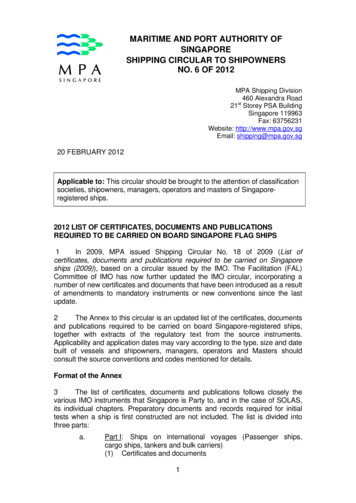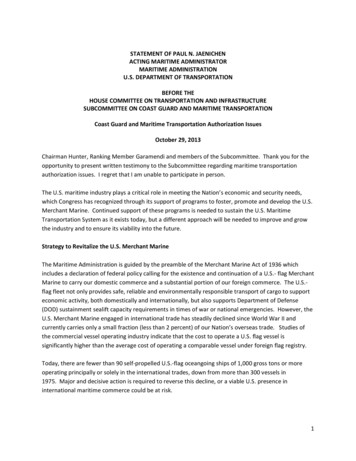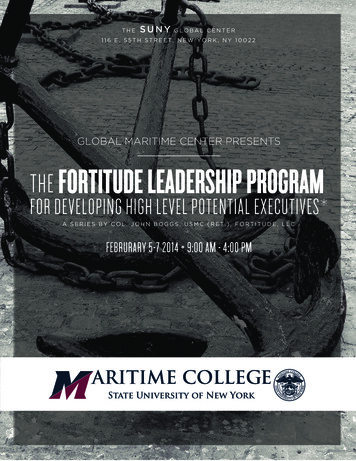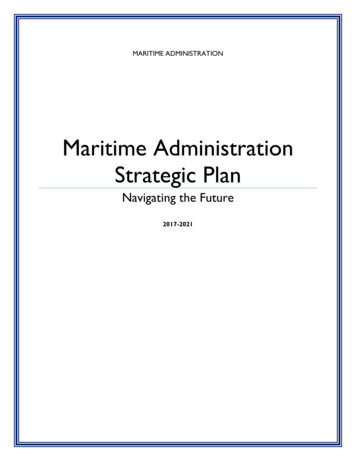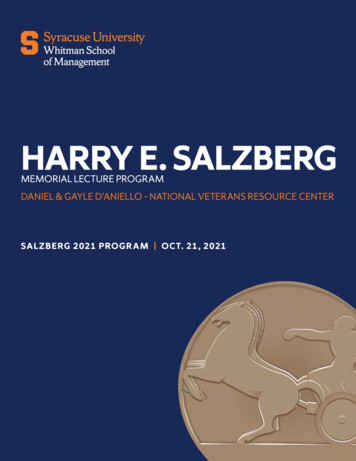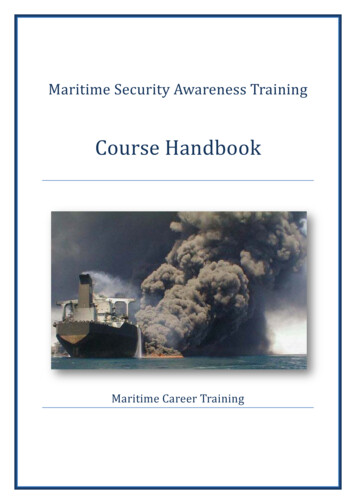
Transcription
THOMAS ROSLYNG OLESENVALUE CREATION INTHE MARITIME CHAINOF TRANSPORTATIONTHE ROLE OF CARRIERS, PORTS AND THIRD PARTIES IN LINER AND BULK SHIPPINGCROSS-DISCIPLINARY AND PROBLEM-FOCUSED RESEARCHAND EDUCATION IN THE MARITIME INDUSTRY CONTEXT
PUBLISHED BY:CBS MARITIMEDECEMBER ONT PAGE PHOTO: SCANPIX/IRISPAGES 9, 19: SCANPIX/IRISPRODUCTION:CBS MARITIMEGRAPHIC PRODUCTION:SKABELONDESIGN A/SISBN: 978-87-93262-01-0
INTRODUCTION . 4PURPOSE AND METHODOLOGY . 5THE CARRIER: THE SHIPPING COMPANY OR SHIP OPERATOR . 10THE ROLE OF (INDEPENDENT) THIRD PARTIES . 13THE LINK BETWEEN THE CONSIGNOR AND THE SHIPPING COMPANY . 14AGENTS OF AFFREIGHTMENT IN LINER SHIPPING . 14The Freight Forwarder . 15The Liner Agent . 16AGENTS OF AFFREIGHTMENT IN TRAMP SHIPPING . 20The Chartering Broker . 20THE DISTRIBUTION OF ASSETS . 24CHARTERING BROKERS AND P&S BROKERS. 24THE PORT OPERATIONS PHASE . 26PORTS AND TERMINAL OPERATORS. 27THE PORT AGENTS. 30THIRD PARTY SHIP MANAGEMENT . 32SUMMARY. 35REFERENCES . 36INTERVIEWS. 38CONTENTSCONTENTS
VALUE CREATION IN THE MARITIME CHAIN OF TRANSPORTATION4INTRODUCTIONThis short report forms part of the ambitious CBS Maritime research initiative entitled “Competitive Challenges andStrategic Development Potential in Global Maritime Industries”, which was launched in 2014 with the generous supportof the Danish Maritime Fund. The competitiveness initiative targets specific maritime industries (including shipping,offshore energy, ports, and maritime service and equipment suppliers) as well as addresses topics that cut across maritimeindustries (regulation and competitiveness). The topics and narrower research questions addressed in the initiative weredeveloped in close dialogue between CBS Maritime and the maritime industries in Denmark.CBS Maritime is a Business in Society (BiS) Platform at Copenhagen Business School committed to the big question ofhow to achieve economic and social progress in the maritime industries. CBS Maritime aims to strengthen a maritimefocus at CBS and create the foundation for CBS as a stronger partner for the maritime industries, as well as for otheruniversities and business schools with a devotion to maritime economics research.The competitiveness initiative comprises a number of PhD projects and five short-term mapping projects, the latteraiming at developing key concepts and building up a basic industry knowledge-base for further development of CBSMaritime research and teaching.This present report “Value Creation in the Maritime Chain of Transportation – The role of carriers, ports and third partiesin liner and bulk shipping” presents preliminary insights from a broader mapping project examining value creation logicsin the maritime value chain. It explains the roles of various actors in the maritime chain of transportation and examineshow these actors create value. The report builds on interviews with key players in the maritime value chain combinedwith studies of the extant shipping industry literature.
The maritime chain of transportation is driven by the demand for transportation of cargo between locations with excesssupply to locations with excess demand. If there is no demand there is no movement and thus no requirement forproviders of transportation. Transport is thus a derived demand and carriers and third party service providers who engagein the chain of transportation must derive value from and add value to the movement (Robinson, 2002).How carriers and agents create value in the maritime chain of transportation is, however, a subject which has beenoverlooked in the existing literature. This is especially the case with regard to the role of the agents and we have verylittle systematic knowledge about their key functions in the creation of value in the maritime chain of transportation.This report addresses four research questions:1.2.3.4.What actors are engaged in the maritime chain of transportation?Where do these actors position themselves in the maritime chain of transportation?What types of services do they perform?How do they add value to the maritime chain of transportation?Value creation can be defined in many ways. From a financial perspective value is created when a business earns revenuethat exceeds the expenses. In many sectors, however, value is increasingly being created by more intangible drivers suchas research, innovation, branding, ideas and networks which usually provide indirect rather than direct benefits (Kaplan &Norton, 2004a; 2004b). The sources of value creation will furthermore differ from industry to industry:“If customers value consistent quality and timely delivery, then the skills, systems and processes that produce and deliverquality products and services are highly valuable to the organization. If customers value innovation and highperformance, then the skills, systems and processes that create new products and services with superior functionality takeon high value. Consistent alignment of actions and capabilities with the customer value proposition is the core of strategyexecution” (Kaplan & Norton, 2004b).According to Kaplan and Norton, the link between these intangible assets and value creation is corporate strategy. Acompany that knows what sources and drivers create value within the industry can deploy capital better and obtain acompetitive advantage (Kaplan & Norton, 2004a; 2004b).As this report shows the chain of transportation is complex in this regard. The assets which allow the chartering broker toprovide a value added service for the shipper or carrier are different than the asset which allows the ship operator toprovide a value added service for the shipper.In order to identify and categorize how different actors create value this report applies four key metrics identified byJohansson et al. (1993). These include: (1) service, (2) quality, (3) cost and (4) time reduction. This framework has beenchosen because it is easy to use, it gives a good overview of how various activities add value, and it can be applied to anysector. According to Johansson et al. (1993) any company – regardless of sector or industry – should thus focus onimproving quality and service while also reducing cycle time and cost to the consumer.Who captures the added value is another question, which depends on the individual transactions between the actors in thechain. A port agent may add value to a carrier by securing smooth port operations and thus reduce waiting time. Theadded value may, however, be captured by a freight forwarder who forces the carrier to lower the price or more likely bedistributed among several actors. The role of sales forces is thus important in this regard (Blocker et al. 2012). Thequestion of value capturing is, however, extremely complex and is not included in this study.PURPOSE AND METHODOLOGYPURPOSE AND METHODOLOGY5
VALUE CREATION IN THE MARITIME CHAIN OF TRANSPORTATION6When examining the shipping sector it is important to distinguish between different kinds of shipping because thedemand for different types of services (and thus the types of value added activities) differs among them. The shippingmarket is basically made up by three segments: (1) Liner shipping, (2) bulk shipping and (3) specialized shipping(Stopford, 2009).Liner shipping companies provide regular services between specified ports according to time-tables and prices advertisedwell in advance. The cargo is mainly carried by container lines in containers or as break bulk. Break bulk is noncontainerized general cargo which is loaded individually (e.g., cars, paper reels, construction machinery). Goods carriedin liner-service ships are usually of higher value than the cargos hauled in tramps, and are charged higher freight rates.The container line will usually carry a vast number of different commodities (Stopford, 2009).Bulk shipping differs from liner shipping in several ways. Most bulk companies operate on the spot markets and have nofixed routes or schedules. This is often referred to as tramp trade. The ships are usually contracted to carry cargo from(any) port to (any) port. The cargo usually consists of a large quantity of a single commodity. It mainly includes dry bulk(ore, coal, fertilizer, grain etc.) carried in bulk carriers and wet bulk (usually crude oil, petrochemicals, gasoline etc.)carried in tankers. The cargo is thus generally of lower value than the (containerized) cargo carried by the liner companies(Stopford, 2009; Lagoudis et al., 2004).Finally, there is the specialized shipping segment. Ships in this segment carry specialized cargo such as chemical gas,refrigerated cargo, forest products, vehicles, heavy lift cargo, offshore equipment, passengers etc. Whereas the bulkmarket consists of hundreds of similar ships competing for homogenous cargo, the specialized shipping segment isextremely differentiated (Stopford, 2009).Foto: Tim Ruttledge, Handelsflådens Velfærdsråds Fotokonkurrence 2012
At a general level the maritime chain of transportation basically consists of a sea voyage and two land basedtransportations. The transportation begins at the production site where the commodities or goods are usually stored beforebeing shipped. From this location they are transported to the port by a truck, train, conveyor or pipeline etc. At the portthey are usually stored again before being loaded on a ship. The ship carries it to the port of arrival where it is dischargedand usually stored before being transported to its final destination (Stopford, 2009).This is obviously an extremely simplified description and there are many differences from liner shipping to bulkshipping. Container ships carry several small parcels, which require a much larger administration than bulk carriers andtankers, which usually carry one single commodity. As a consequence the chain of transportation in bulk shipping isusually shorter than in liner shipping and includes fewer actors. The simplified model, however, gives a good startingpoint for analyzing the various actors within the chain.The report is divided into a number of sections which examine the roles and activities of various actors. The role of thecarrier is being examined in section 3. In the maritime chain of transportation the most important carrier is the shippingcompany or shipping operators which provide the actual transportation from port A to port B. Many shipping companieshave, however, also integrated backwards and are increasingly engaged in port operations and land based transportation.So even if the inland providers of transportation – railways, trucks, barges and other haulage providers – are not exclusiveto the maritime chain of transportation, they are briefly mentioned in the section about agents of affreightment.The subsequent sections focus on the role of the (independent) third parties in the maritime chain of transportation. Page13 offers a brief introduction to the independent third parties, while page 14 examines the link between the consignor andPURPOSE AND METHODOLOGY7This report focuses on value creation in liner shipping and bulk shipping (dry bulk and wet bulk). The outset for thereport is a paper by Lyridis et al. (2005) on liner shipping and a paper by Lagoudis et al. (2004) on dry bulk and wet bulk.Both studies have applied a business process model approach. Business process modelling is basically used to describethe processes within a business. It uses a top down approach with several levels from the overall business process todetailed activity descriptions. Each new level thus offers a higher degree of details. The two papers provide a goodfoundation for examining the activities in the two segments and identify how different actors provide value addedservices (Lyridis et al. 2005; Lagoudis et al. 2004).
VALUE CREATION IN THE MARITIME CHAIN OF TRANSPORTATION8the shipping company. Pages 14 to 19 examine the agents of affreightment in liner shipping – the freight forwarder andthe liner agent. Pages 20 to 23 examine the role of the chartering broker who connects the consignor and the carrier(s) intramp shipping. The chartering broker is furthermore engaged in the distribution of assets (ships) among ship operator,which is being examined on pages 24 to 25. This section also examines the role of the purchase and sales broker. Pages26 to31 examine the role of the ports in the maritime chain of transportation. This includes the port and terminal operatorsand the port agents. Finally, pages 32 to 34 examine the role of third party ship management companies. The report isconcluded with a brief summary on page 35.
THE CARRIER: THE SHIPPINGCOMPANY OR SHIP OPERATORPURPOSE AND METHODOLOGY9
VALUE CREATION IN THE MARITIME CHAIN OF TRANSPORTATION10THE CARRIER: THE SHIPPINGCOMPANY OR SHIP OPERATORAs the main carrier of goods from port A to port B the shipping company or ship operator is a key actor in the maritimechain of transportation. The shipping company adds value to the customer/consignor by transporting his goods from areaswith excess supply to areas with excess demand.The organization of a shipping company may take many different forms depending on size, strategy and sector. In earliertimes the shipping company would often own the ships. Today a ship operator may charter in all the tonnage or part of it.Ship owners, on the other hand, may be banks or other financial institutions which are not usually considered as coreactors in the maritime sector.This section examines the responsibilities of the various departments in a shipping company. Although there is nostandard shipping organization a shipping company will usually have a central board of management with a generalsecretariat attached to it. The management oversees a number of separate divisions and departments which typicallyincludes a commercial division, an operations department, a technical division, an administrative department, a financialand accounting department and a legal claims and insurance department. The responsibilities of the various departmentsmay vary from company to company and several activities which used to be performed in-house may be outsourced toindependent third parties. (Sornn-Friese, 2010; Sornn-Friese & Hansen, 2012; Lagoudis et al., 2004; Lyridis et al., 2005;Iolcos, 2015).The board of management is responsible for the development and implementation of the company strategy, corporatecommunication everyday management and company organization. The board is headed by a Chief Executive Officer(CEO). Top management often also include an executive vice president who is often the Chief Financial Officer (CFO)and a number of senior vice presidents and managing directors who are generally the heads of the various departments inthe company. The top management reports to a board of directors which is responsible for the overall strategicdevelopment in close cooperation with the CEO and CFO. Top management usually has a corporate secretariat which isresponsible for coordinating and supervising the other departments and maintaining investor relations (Sornn-Friese &Hansen, 2012).The commercial division is the business generator of the company. Diversified shipping companies will usually haveseparate departments for liners, tankers and dry cargo operations. In tramp shipping (usually dry bulk or wet bulkoperations) most contracts are spot market voyage charters which are handled by a chartering department. The charteringdepartment usually operates through independent shipbrokers that connect them with potential customers. In this processthe chartering team tries to locate the most suitable business for the vessels and negotiate the best hire rates and terms fortheir disposal. In some cases the department may also be responsible for the purchase and sale of ships (Lagoudis et al.,2004; Iolcos, 2015). In liner shipping it is usually a network of local branch offices or (independent) liner agents situatedin key locations which are responsible for marketing, booking of cargo, arranging transportation to and from the port etc.The operations department is often part of the commercial division. The department is responsible for the daily operationsand provides solutions to any potential problem which may arise. In doing this the department has an important role ascoordinator between the master of the vessel, the various departments in the company and the independent agents. Thedepartment will provide information on routes, charts, bunkers provisions status etc. and will often also be responsible formonitoring the fleet performance (Lagoudis et al., 2004; Iolcos, 2015).
The purchase and stores department may be a part of the technical division or it may exist as an individual department. Itis charged with the task of supplying the vessels with the necessary spares, stores, paints, lubricants, chemicals, bunkersetc. The department is usually responsible for negotiating the purchasing prices and terms with the company's majorsuppliers (Iolcos, 2015).The accounting and finance department will handle all the financial transactions of the company. The departmentmanages all available financial resources, monitors the inflows and outflows, schedules payments to suppliers, shipyards,agents, etc. It monitors the fiscal activities of the company and is responsible for seeking (and carrying through) thenecessary funding for these activities, be it traditional bank financing or alternative sources. The department isresponsible for maintaining and promoting the company’s relations with banks, investment firms and other financialmarket participants. It manages, allocates and invests the company’s cash reserves and working capital and other assetsand suggests appropriate alternatives. Furthermore, it evaluates the financial viability of prospective investments of thecompany’s clients and keeps up with the progress of the existing ones. It oversees the repayment of the company's loanobligations and taxes. Regular accounting reports are prepared for the company, the departments and for each ship. Thedepartment is also engaged in formulating the company’s annual budget and budget projections for the coming years. TheCFO – which is head of the department – is normally part of the top management and through him the department keepsthe top management informed on the financial situation (Sornn-Friese & Hansen, 2012; Iolcos, 2015).The legal claims and marine insurance department covers all legal matters for the company. Among the main functionscan be mentioned contracts for new buildings, company law, national/international taxes, purchase/sale of ships. Thecompany lawyer is also often on the managing director's staff, and/or secretary to the board of directors.The legal claims and marine insurance department is responsible for the process of insuring ships, cargos and crewmembers. This process entails the careful examination of all insurance policies and the relevant invoices, as well as themonitoring of the strict adherence to their clauses. Furthermore, it is responsible for advising the top management aboutthe annual insurance costs per vessel and per fleet, and keeping the various departments up-to-date about the effects ofpossible moves that may not be covered by the insurance.Legal claims and marine insurance is furthermore responsible for all the necessary actions that need to be taken in casesof claims arising from hull damage, damaged machinery, and cargo claims etc. The department also follows up on claimsthat may arise from stevedoring damages, stowaways, injuries, and accidents etc. These claim adjustments causeconsiderable work, particularly within liner shipping. For this purpose it is in close cooperation with all the otherdepartments and especially the technical and operations departments. It is also customary for shipping companies aroundthe world to outsource certain tasks to external legal offices and professional P&I Clubs (Protection and Indemnity Clubs)which provide third party liability-cover for risks not recoverable under standard marine insurance policies (Sornn-Friese& Hansen, 2012; Iolcos, 2015). P&I Clubs are mutual insurance associations which provide risk pooling, information and11THE CARRIER: THE SHIPPING COMPANY OR SHIP OPERATORThe technical division generally encompasses a marine department and a technical department. The marine department isresponsible for crewing and daily maintenance. The department is furthermore responsible for the running certification,evaluation, assessment and administration of the crew. The technical department is responsible for the technical operationof the ships including ship surveying, repair and maintenance of propulsion systems, boilers, cranes, pumps and othermechanical and electrical systems. The technical department may also provide inspectors to supervise dry-dockings andother repairs. The technical department is usually also responsible for the relationship with the classification societies andthe renewal of all ship certificates whenever necessary. This also includes compliance with various conventions and legaldemands. The technical department usually monitors the inventories of spares and stores, the chemical testing of bunkersand lubricants and the selection and dispatch of specialized teams on board to carry out repairs. It is also responsible forreviewing technical reports, and appraising the overall performance of the engines. Finally, the technical department canprovide the necessary expertise on technical conditions with regard to shipbuilding, purchase and sales. The departmentmay thus deploy superintendents at shipyards which build new ships for the company. In some cases the technicaldivision may be charged with the safety of the ships and their crew members, by making sure that all necessary safetyitems are provided on a regular and scheduled basis and by upholding a quality control system using the InternationalSafety Management (ISM) Code (Iolcos, 2015). In the past decades the responsibilities of the technical division haveincreasingly been outsourced to external ship management companies.
VALUE CREATION IN THE MARITIME CHAIN OF TRANSPORTATION12representation for its members. Whereas a marine insurance company will report to its shareholders, a P&I Club reportsonly to its members. Originally, P&I Clubs were only for ship owners and operators but in the recent years freightforwarders and warehouse operators have been able to join.In order to ensure safety at sea, prevent human injuries and avoid damage to ships and the environment, all shippingcompanies are required to follow a set of global standards as which are specified in the International Convention for theSafety of Life at Sea (SOLAS). The revised 1978 STCV convention (Standards of Training, Certification andWatchkeeping) provides the means for developing a safety culture through the education and training of seafarers. In1998 the International Safety Management Code (ISM) was adopted by the SOLAS treaty in order to develop a cultureand of safety and environmental ethics throughout the shipping company. Under these regulations a shipping company isrequired to enforce and verify a safety management system which provides the necessary procedures and guidelines forthe safe navigation of each vessel. These safety issues have traditionally been handled by the technical department butshipping companies have increasingly begun to establish separate HSSEQ departments responsible for issues relating tohealth, safety, security, environment and quality (Sornn-Friese & Hansen, 2012).It has become customary for many larger shipping companies to have a professional R&D department which isresponsible for complex research tasks such as market analysis, strategies and technological developments andopportunities in relation to the company’s assets and activities. R&D projects cover a wide range of activities at sea andashore in accountability, financial control, information and communication systems, automation, cargo handling andother operational systems, maintenance etc.The Administrative department is responsible for the main organization, for personnel (HR), internal services and internalcontrol. The importance of a sensible employment policy combined with systematic training has been given increasedemphasis. Internal control covers the traditional auditing as well as the more detailed control work required to ensure thatthe organization works according to the company policy.The responsibilities of the IT department include finding and/or developing, evaluating and maintaining the operators ITsystems. Especially within liner shipping IT solutions are vital for tracking, tracing and securing the timely transport ofeach individual container. In the past decade most liner shipping operators have furthermore given customers access toonline track-and-trace solutions. And several liner operators have developed joint IT systems with key clients in order toprovide a better service (and raise the switching costs). Moreover, on a day-to-day basis, the department deals with theelectronic data processing functions of the company, the maintenance and upgrading/updating of the company's intranet,the support of all users and the monitoring of the proper functioning of the internal and external communications. Finally,the IT Department is responsible for suggesting the appropriate specifications for all computer-related equipment, bothfor the head offices and for the vessels (Iolcos, 2015).Finally, many shipping companies may have an Information & Communication department, which manages all internaland external communication. It basically coordinates and controls all messages to employees, media, stakeholders and thegeneral public. The department secures a clear communication strategy which helps the company to explain its missionand combine its many visions and values.
Even if the shipping company or shipping operator may arrange and carry out the entire transportation in-house, mosttransactions will involve a number of (independent) third parties. The consignor/shipper (the cargo holder) may hire afreight forwarder or a chartering broker to arrange the transportation and most shipping companies will have a network of(independent) business connections such as shipbrokers, port agents, stevedores, ship management companies etc.Whether to integrate or outsource a service depends on the value added by the third parties compared to the transactioncosts. Transaction costs include (1) search and information costs (searching for and finding the provider with the lowestcosts), (2) bargaining costs (agreeing on the transaction) and (3) enforcement costs (monitoring and enforcingimplementation of the contract). Transaction cost economics suggests that the costs and difficulties associated withmarket transactions sometimes favor in-house production and sometimes outsourcing. An intermediate mechanism, calledhybrid or relational, between these two extremes has also emerged (Williamson, 1979, 1981 & 1985). For most shipoperators this is especially the case with regard to ship management services. The following sections will examine h
providers of transportation. Transport is thus a derived demand and carriers and third party service providers who engage in the chain of transportation must derive value from and add value to the movement (Robinson, 2002). How carriers and agents create value in the maritime chain of transportation is, however, a subject which has been


